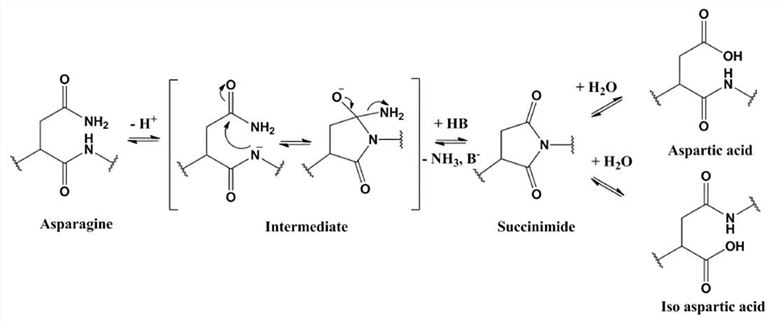Deamidation of asparagine (Asn) is a major cause of chemical degradation and have a negative impact on drug efficacy and stability if the compounds are not formulated and properly stored. Therefore, deamidation assay is an important aspect of biotherapeutic protein analysis. With advanced instruments and extensive experience, Creative Biolabs offers a variety of deamidation assay services to accelerate the drug discovery process for our customers.
Chemical stability is a major concern in the development of protein therapeutics because of its impact on both efficacy and safety. Protein "hotspots" are amino acid residues that undergo various chemical modifications, including deamidation, oxidation, isomerization, glycosylation and the like. Deamidation mainly happens on an Asn residue, in which the side-chain amide group of Asn residue is converted into an acidic carboxylate group. In this process, an intermediate closed-loop succinimide residue is formed. The succinimide residue is then subjected to rapid hydrolysis to produce the final product aspartic acid (Asp) or iso aspartic acid (IsoAsp) (Fig.1). In addition, glutamine (GIn) residue can also undergo the deamidation process, but GIn deamidation occurs much more slowly than Asn, so it is less concerned. Asn deamidation in biological drugs is the main cause of degradation if the therapeutical proteins are not formulated and stored appropriately. If deamidation occurs in the antigen-binding region of the monoclonal antibodies (mAbs), the antibody's binding potency can be affected. Therefore, Asn deamidation assay is a very important step during the engineering process of therapeutical protein development.
 Fig.1 Chemical reaction of asparagine deamidation process. (Jia, 2017)
Fig.1 Chemical reaction of asparagine deamidation process. (Jia, 2017)
At present, there are many methods to determine the products (such as IsoAsp and succinimide) of the deamidation reaction, including high-performance liquid chromatography (HPLC), mass spectrometry (MS), peptide mapping based on the low-pH protein digestion method, urea gel electrophoresis, reverse phase, ion exchange, and hydrophobic interaction chromatography methods. At Creative Biolabs, we provide high quality assays to help predict deamidation sites in proteins and peptides and help develop deamidation-resistant biological therapeutics. Some of the deamidation assay methods are listed below.
We offer the best expertise in our field to support your needs. If you would like more information about our services, please feel free to contact us.
Reference
All listed services and products are For Research Use Only. Do Not use in any diagnostic or therapeutic applications.